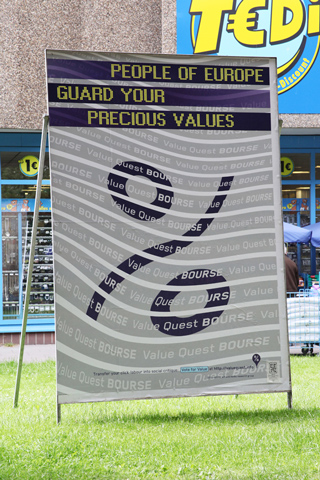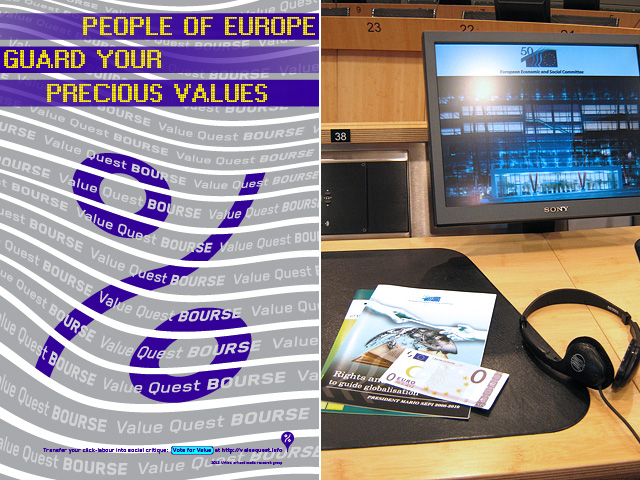
|
People of Europe, Guard Your Precious ValuesPoster in public space
|
- Photo doc
-
Art and Economy
An aesthetics and ethics based on the balance sheet of profits and losses
-
Keywords / Tags
- Aestheticization of Politics,
- Eurozone Crisis,
- Bankruptcy,
- Greed Economy,
- Art In Public Space
Art-Bio:
Premiere
- 2012
- "People of Europe, Guard Your Precious Values," plakartive.de an exhibition of billboards in the public space Kunst.Stadt.Plakat, Bielefeld, 22.6 to 31.8 2012. Idea: Uwe Göbel
A poster "People of Europe Guard Your Precious Values" at Plakartive, Bielefeld (photo: Svenja Hemke)
urtica's poster at plakartive

A poster "People of Europe, Guard Your Precious Values" is displayed on the occasion of plakartive.de, an exhibition in the public space Kunst.Stadt.Plakat in Bielefeld, Germany, 2012
Urtica’s statement:
"The people cannot decide until somebody decides who are the people." (Sir William Ivor Jennings)
Current sovereign debt crisis of Greece, Portugal, Italy, Ireland and Spain, brought a fear that Eurozone will collapse. As the differentiation between rich and poor, center and periphery are growing, the politicians behave as if they are running private corporations. Rising government deficits and debt levels (due to the massive bank bailouts and public sector shortfall) resulted in downgrading of countries’ credit ratings which caused crisis of confidence in financial markets and crisis of solidarity in a social sphere. The crisis and budget deficit are often used as an alibi for economic nationalism which brings us to the FAQ "Whose is our money?"
An European multi-layered crisis of confidence provoked us to create an Art-Alert “People of Europe, guard your precious values.” It is titled after the critical drawing by George Grosz “Völker Europas, wahrt eure heiligsten Güter” ironically named after Hermann Knackfuß's gravure form 1895. Grosz's drawing was part of the collection published in 1923 in Berlin, translated as “One Day We’ll Get Even” or “The Day of Reckoning.” Those drawings, like Grosz described it, "are not documents of the class struggle, but eternally living documents of human stupidity and brutality." He depicted chaotic shift in German society emerged after the First World War: the scenes of the social immorality, the collapse of middle class, the downturn of economy and political-business corruptive scheme. Sounds contemporary?
The dominant neoliberal paradigm, which equated cultural and social policy to economic, knocked down European welfare society. A poster “People of Europe, guard your precious values,” made by Urtica on the occasion of plakartive.de, captures that new spirit of aesthetics and ethics based on the balance sheet of profits and losses. A hint of blue and yellow drown in bureaucratic grayness. Thus poster features an interest-payment symbol, the percent [ % ], as an ironic leitmotif for the question what is the European value that connects?
Built in 50s upon the Treaty establishing the European Coal and Steel Community, the European Union is funded on ideas related to the economic prosperity (creation of the single market) and the stability (maintaining the peace in Europe). In order to enable the flow of capital and prevent wide exchange fluctuations between the European currencies, the European Monetary System (EMS) was introduced in March 1979. It consisted of a reference currency called the ecu, an exchange rate mechanism, and a credit mechanism. After the reunification of Germany and extended currency pressures within Europe as a result of fluctuations and competitive devaluations of currencies, EMS evolved into the Economic and Monetary Union (EMU) that was adopted via Maastricht Treaty in December 1991. The final stage of EMU was the full monetary union and introduction of the Euro in January 2002. But, not all EU member states adopted Euro, e.g., when an old lady was asked in TV query why didn't The Great Britain accept Euro, her laconic reply was "'Cause we are British!"
Beside serving as a common measure of value, a deposit of value, and a medium of exchange, the Euro is encrypted cultural artifact that tells about socioeconomic circumstances. For instance, to keep national states from quarrel and to skip controversial debate on European identity, the design of the Euro-banknote series does not represent any real buildings or people. The visual identity is based on fictitious buildings that illustrates important architectural styles of European history: the front side features windows and arcs as a symbol for openness within Europe, whereas the bridge on the back side is intended as a symbol for Europe's connection to the rest of the world. But to fully understand the notion of EU aesthetic decorum one should bare in mind that EU is not interested in art, only in culture (as I was told during my visit to European Parliament). I was also told that the kitsch fair widely known as The Eurovision Song is the major cultural event of Europe. Obviously the winning marketing formula for aestheticization of politics is No Art, Just Culture! Which lead us to Boris Groys standpoint "instead of changing the world, art only makes it look better."
A photo "0Euro banknote at the European Economic and Social Committee," that took place in Brussels on December 2008, captured the moment when art and a real-life context intersect the EU bureaucratic matrix. The 0Euro issued by 0Euro Bank is a creation of artist Michael Aschauer. Conceptually it interlaces the issues of hard-talk politics with the aesthetic and economic spheres. In contrast to the idyll of original euro, the design of Zero Euro positions Turkey’s half moon into the void of banknote's front-side, while its back depicts real bridge modeled after the ’Bridge of Liberty’ in Novi Sad (Serbia) as it looked like after being bombed by NATO in 1999. The first 0Euro was made in 2004 at the time when the "Bridge of Liberty" was still broken. It has been rebuild via donation of European Agency for Reconstruction and reopened in 2005… A surge of anxiety, caused by global recession and economic crisis that burst in 2008, has brought new interpretation of the Euro design. "The arc as a symbol for openness within Europe" has been closing while the rich center is blaming the poor periphery for an export of cheep labor power that dumps the price of wage labour. On the other hand "the bridge as a symbol for Europe's connection to the rest of the world," became a topic of political-business corruptive affairs when poor periphery accused rich center for neocolonialism, i.e., "the building of the bridge" became an excuse for the market takeover.
Every schoolkid knows that map is not a territory, like the bureaucratic matrix of the European Union is not Europe… But every schoolkid should also know that the financial market does not react upon objective reality, but upon current views of how others perceived future behavior of the market. Thus the value of an asset, in this case Euro, depends on psychological trust in the concept that stands behind it, as well as of the expectation of future profits flows. The confidence of other agents in the market is essential. A corollary: While the two are making a row, the third is taking advantage, meaning that the speculators have waged bets against the European currency/economy. Caught in a net of distrust, the European players' doubt resemble Bob Rock's question "But what shall we do Alan, there are two of them and we are all alone?" (Alan Ford comic book)
Written on a very hot day 22nd of Jun 2012 by Violeta Vojvodić Balaž

 People of Europe, Guard Your Precious Values
People of Europe, Guard Your Precious Values The Art in Liquidation
The Art in Liquidation Art and Crisis - Facing Bureaucrat (video)
Art and Crisis - Facing Bureaucrat (video) VQ Bourse - The Value is Here
VQ Bourse - The Value is Here VQ - Art of Fortune and Economy of Risk
VQ - Art of Fortune and Economy of Risk VQ - Golden Card
VQ - Golden Card That Which Changes
That Which Changes Who is Guarding the Guardians?
Who is Guarding the Guardians? Social Engine
Social Engine Dictionary of Primal Behaviour
Dictionary of Primal Behaviour Lapsus Memoriae
Lapsus Memoriae Kumova Sekira
Kumova Sekira Omnigenus
Omnigenus Urtica Medicamentum Est
Urtica Medicamentum Est Social Engine - The Hybrid Source Book
Social Engine - The Hybrid Source Book
